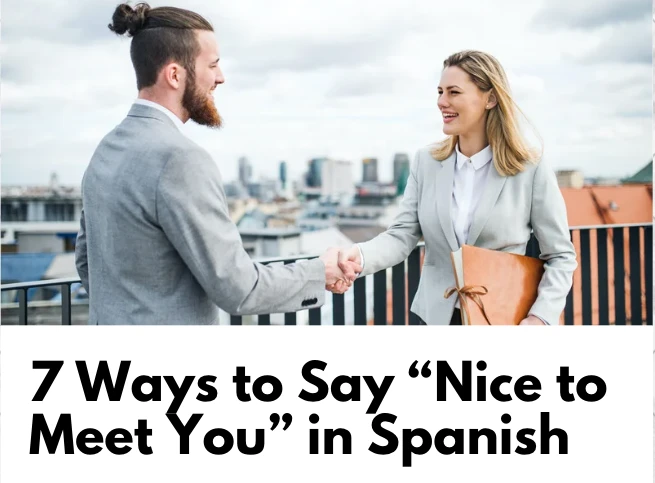If you’re learning Spanish, using common phrases like “Nice to meet you” is a great way to practice the language in real-life situations. If you’re going to meet Spanish-speaking individuals for business reason, it creates a positive impression and shows respect if you greet them in their language.
Or if you’re traveling in Spanish-speaking countries, using basic local phrases is not only polite but also enhances the travel experience. It can open up more interactions with locals and enrich the cultural experience.
“Nice to meet you” is a simple greeting, but it can quickly build rapport and a sense of connection. It shows a willingness to connect on a personal level and can make the other person feel more at ease.
This article will take you through 7 options you can use to say “Nice to meet you” in Spanish when you meet and talk with Spanish Speakers in the future. Let’s have a look.
1. Mucho gusto / Nice to meet you
This is one of the universal ways to say “Nice to meet you” in Spanish. You can use it in both formal and informal introductions.
Examples:
- A: Mi nombre es Gabriel, mucho gusto. / My name is Gabriel, nice to meet you.
- B: Te presento a Marina, mi nueva compañera de trabajo. / This is Marina, my new coworker.
- A: Mucho gusto Marina. / Nice to meet you Marina.
2. Mucho gusto en conocerte / It’s very nice to meet you
This expression is an extension of the previous one. It translates almost the same way, but is a more elaborate and elevated way to say “Nice to meet you”. If you want to make sure the other person knows you are very pleased to meet them, this is the way to go.
Example:
- A: Déjame presentarte a Leonardo Di Caprio. / Let me introduce you to Leonardo Di Caprio.
- B: ¡Mucho gusto en conocerte Leo! / It is very nice to meet you Leo!
3. Encantado / Pleased to meet you
This is a quick and formal way to express that you are happy to meet someone. It is mostly used in countries like Spain and is the equivalent to the phrase enchanté in French. Be aware that Spanish applies grammatical gender, so the word encantado changes if a woman is the speaker. In that case you have to use encantada.
Examples:
- Al fin nos conocemos, encantado. / Finally we meet, I’m delighted to meet you.
- Hola, mi nombre es Marina, encantada. / Hi, my name is Marina, I’m pleased to meet you.
4. Encantado de conocerte/conocerlo / It’s a pleasure to meet you
This expression holds a higher degree of a formality than “mucho gusto”. It translates as “It’s a pleasure to meet you”. It is most used in working environments. Spanish uses different subject pronouns depending on the level of familiarity. So, if you meet someone who is older or holds a position of authority, you have to say “encantado de conocerlo”.
Example:
- Buenas tardes señora Presidenta, encantado de conocerla. / Good afternoon Madam President, it’s a pleasure to meet you.
5. Es un placer / It’s a pleasure
You can use “Es un placer” in many different situations, formal or informal. It literally translates as “It’s a pleasure”. If you are looking for a more delicate response, it’s a great substitute for “mucho gusto”.
Example:
- A: Esta es mi esposa, Claudia. / This is my wife, Claudia.
- B: Es un placer, Claudia. / It’s a pleasure, Claudia.
6. He escuchado mucho sobre ti / I’ve heard a lot about you
This phrase means “I’ve heard so much about you.” In the same way, as in English, you can use this expression when you meet someone with whom you are familiar. Perhaps a friend or acquaintance has told you about this person before. If you want to let them know you were looking forward to meeting them, use this introduction.
Example:
- ¿Tú eres la famosa Marina? ¡He escuchado mucho sobre ti! / Are you the famous Marina? I’ve heard so much about you!
7. ¿Qué tal? / How do you do?
“¿Qué tal?” is a common expression Spanish speakers use when they meet someone. We recommend you use it in more informal situations. You can even combine this with some of the phrases we explored before.
Examples:
- ¿Qué tal? Mi nombre es Juan. / How do you do? My name is Juan.
- A: Te presento a Claudia. / This is Claudia.
- B: ¿Qué tal, Claudia? Un placer conocerte. / How do you do Claudia? It’s a pleasure to meet you.
How to Respond to “Nice to meet you” in Spanish
Once you know how to greet someone, now you need to know how to reply back. As in English, if the other person takes the lead, in Spanish there are also common phrases to respond in a polite manner. Here are some examples you can use if you are in the middle of an exchange:
1. Igualmente / Likewise
You can use this reply in informal situations when you introduce yourself to friends or neighbors.
Example:
- A: Hola, mi nombre es Marina. / Hi, My name is Marina.
- B: Soy Juan. Un placer conocerte, Marina. / I’m Juan. Pleased to meet you, Marina.
- A: Igualmente. / Likewise.
2. Lo mismo / Same here
This expression is even more informal than “Igualmente”, so use it wisely.
Example:
- A: Mucho gusto Claudia. / Nice to meet you, Claudia.
- B: Gracias, lo mismo. / Thanks, same here.
3. El placer es mío / The pleasure is mine
This is a more formal expression than the two previous ones. You can use it in a work or academic environment. It is a direct response to “Un placer conocerte” (“It’s a pleasure to meet you”)
Example:
- A: Buenos días, soy la profesora Fernández, un placer conocerlo. / Good morning, I’m Professor Fernández, it’s a pleasure to meet you.
- B: El placer es mío. / Pleased to meet you too.
Conclusion
Whether you are a frequent traveler or would like to meet Spanish-speaking people, it is important to start with the basics. That’s why knowing how to greet them properly is so important. These 7 ways to tell someone you are happy to make their acquaintance will help you make an excellent first impression.
Remember the key phrases we learned:
- Mucho gusto.
- Mucho gusto en conocerte.
- Encantado/Encantada.
- Encantado de conocerte/conocerlo.
- Es un placer.
- He escuchado mucho sobre ti.
- ¿Qué tal?
Keep in mind the different grades of formality and the gender pronouns. If you follow these rules you will know when to apply each of them. Now you are ready to meet and talk with Spanish-speaking people. ¡La mejor de las suertes!




